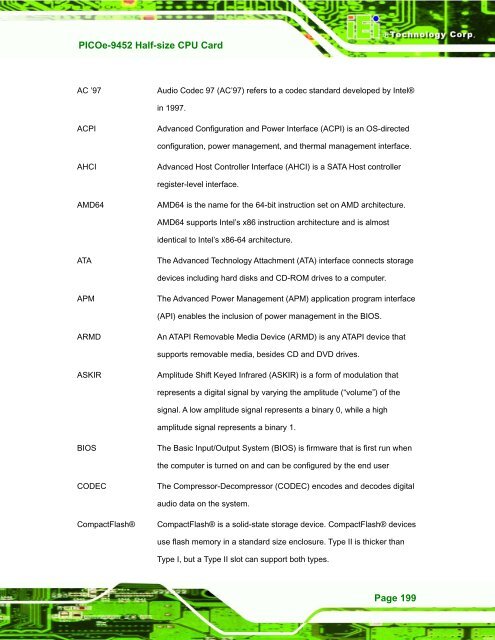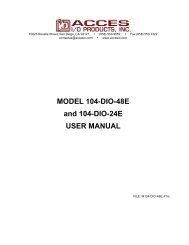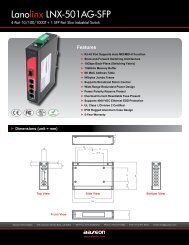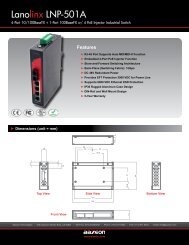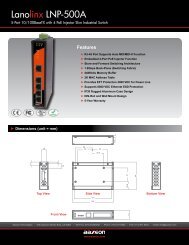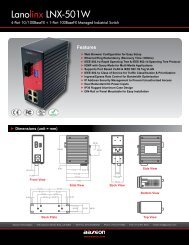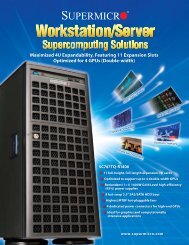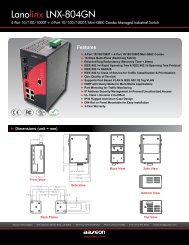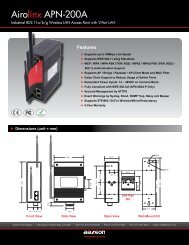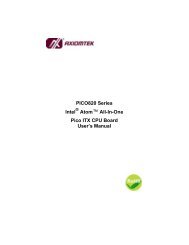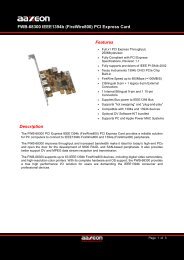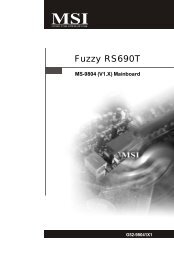- Page 1 and 2:
PICOe-9452 Half-size CPU Card Rev.
- Page 3 and 4:
PICOe-9452 Half-size CPU Card Copyr
- Page 5 and 6:
PICOe-9452 Half-size CPU Card CAUTI
- Page 7 and 8:
PICOe-9452 Half-size CPU Card Table
- Page 9 and 10:
PICOe-9452 Half-size CPU Card 3.2 U
- Page 11 and 12:
PICOe-9452 Half-size CPU Card 6.1.2
- Page 13 and 14:
PICOe-9452 Half-size CPU Card List
- Page 15 and 16:
PICOe-9452 Half-size CPU Card Figur
- Page 17 and 18:
PICOe-9452 Half-size CPU Card Table
- Page 19 and 20:
PICOe-9452 Half-size CPU Card Chapt
- Page 21 and 22:
1.1 Introduction Figure 1-1: PICOe-
- Page 23 and 24:
PICOe-9452 Half-size CPU Card Page
- Page 25 and 26:
PICOe-9452 Half-size CPU Card Page
- Page 27 and 28:
PICOe-9452 Half-size CPU Card Page
- Page 29 and 30:
PICOe-9452 Half-size CPU Card Page
- Page 31 and 32:
PICOe-9452 Half-size CPU Card Page
- Page 33 and 34:
PICOe-9452 Half-size CPU Card Page
- Page 35 and 36:
PICOe-9452 Half-size CPU Card Page
- Page 37 and 38:
PICOe-9452 Half-size CPU Card Page
- Page 39 and 40:
PICOe-9452 Half-size CPU Card Page
- Page 41 and 42:
PICOe-9452 Half-size CPU Card Page
- Page 43 and 44:
PICOe-9452 Half-size CPU Card Page
- Page 45 and 46:
PICOe-9452 Half-size CPU Card Page
- Page 47 and 48:
PICOe-9452 Half-size CPU Card Page
- Page 49 and 50:
PICOe-9452 Half-size CPU Card Page
- Page 51 and 52:
PICOe-9452 Half-size CPU Card Page
- Page 53 and 54:
PICOe-9452 Half-size CPU Card Page
- Page 55 and 56:
PICOe-9452 Half-size CPU Card Page
- Page 57 and 58:
PICOe-9452 Half-size CPU Card Page
- Page 59 and 60:
3.1 Anti-static Precautions WARNING
- Page 61 and 62:
PICOe-9452 Half-size CPU Card Page
- Page 63 and 64:
PICOe-9452 Half-size CPU Card Page
- Page 65 and 66:
PICOe-9452 Half-size CPU Card Page
- Page 67 and 68:
PICOe-9452 Half-size CPU Card Page
- Page 69 and 70:
PICOe-9452 Half-size CPU Card Page
- Page 71 and 72:
PICOe-9452 Half-size CPU Card Page
- Page 73 and 74:
PICOe-9452 Half-size CPU Card Page
- Page 75 and 76:
PICOe-9452 Half-size CPU Card Page
- Page 77 and 78:
PICOe-9452 Half-size CPU Card Page
- Page 79 and 80:
PICOe-9452 Half-size CPU Card Page
- Page 81 and 82:
PICOe-9452 Half-size CPU Card Page
- Page 83 and 84:
PICOe-9452 Half-size CPU Card Page
- Page 85 and 86:
PICOe-9452 Half-size CPU Card Page
- Page 87 and 88:
PICOe-9452 Half-size CPU Card Page
- Page 89 and 90:
PICOe-9452 Half-size CPU Card Page
- Page 91 and 92:
PICOe-9452 Half-size CPU Card Page
- Page 93 and 94:
PICOe-9452 Half-size CPU Card Page
- Page 95 and 96:
PICOe-9452 Half-size CPU Card Page
- Page 97 and 98:
PICOe-9452 Half-size CPU Card Page
- Page 99 and 100:
PICOe-9452 Half-size CPU Card Page
- Page 101 and 102:
PICOe-9452 Half-size CPU Card Page
- Page 103 and 104:
PICOe-9452 Half-size CPU Card Page
- Page 105 and 106:
PICOe-9452 Half-size CPU Card Page
- Page 107 and 108:
PICOe-9452 Half-size CPU Card Page
- Page 109 and 110:
PICOe-9452 Half-size CPU Card Page
- Page 111 and 112:
PICOe-9452 Half-size CPU Card Page
- Page 113 and 114:
PICOe-9452 Half-size CPU Card Page
- Page 115 and 116:
PICOe-9452 Half-size CPU Card Page
- Page 117 and 118:
PICOe-9452 Half-size CPU Card Page
- Page 119 and 120:
PICOe-9452 Half-size CPU Card Page
- Page 121 and 122:
PICOe-9452 Half-size CPU Card Page
- Page 123 and 124:
PICOe-9452 Half-size CPU Card Page
- Page 125 and 126:
PICOe-9452 Half-size CPU Card Page
- Page 127 and 128:
PICOe-9452 Half-size CPU Card Page
- Page 129 and 130:
PICOe-9452 Half-size CPU Card Page
- Page 131 and 132:
PICOe-9452 Half-size CPU Card Page
- Page 133 and 134:
PICOe-9452 Half-size CPU Card Page
- Page 135 and 136:
PICOe-9452 Half-size CPU Card Page
- Page 137 and 138:
PICOe-9452 Half-size CPU Card Page
- Page 139 and 140:
PICOe-9452 Half-size CPU Card Page
- Page 141 and 142:
PICOe-9452 Half-size CPU Card Page
- Page 143 and 144:
PICOe-9452 Half-size CPU Card Page
- Page 145 and 146:
PICOe-9452 Half-size CPU Card Page
- Page 147 and 148:
PICOe-9452 Half-size CPU Card Page
- Page 149 and 150:
PICOe-9452 Half-size CPU Card Page
- Page 151 and 152:
PICOe-9452 Half-size CPU Card Page
- Page 153 and 154:
PICOe-9452 Half-size CPU Card Page
- Page 155 and 156:
PICOe-9452 Half-size CPU Card Page
- Page 157 and 158:
PICOe-9452 Half-size CPU Card Page
- Page 159 and 160:
PICOe-9452 Half-size CPU Card Page
- Page 161 and 162:
PICOe-9452 Half-size CPU Card Page
- Page 163 and 164:
PICOe-9452 Half-size CPU Card Page
- Page 165 and 166: PICOe-9452 Half-size CPU Card Page
- Page 167 and 168: PICOe-9452 Half-size CPU Card BIOS
- Page 169 and 170: PICOe-9452 Half-size CPU Card Page
- Page 171 and 172: PICOe-9452 Half-size CPU Card Page
- Page 173 and 174: PICOe-9452 Half-size CPU Card Page
- Page 175 and 176: PICOe-9452 Half-size CPU Card Page
- Page 177 and 178: PICOe-9452 Half-size CPU Card Page
- Page 179 and 180: PICOe-9452 Half-size CPU Card Page
- Page 181 and 182: PICOe-9452 Half-size CPU Card Page
- Page 183 and 184: PICOe-9452 Half-size CPU Card Page
- Page 185 and 186: PICOe-9452 Half-size CPU Card Figur
- Page 187 and 188: PICOe-9452 Half-size CPU Card Page
- Page 189 and 190: PICOe-9452 Half-size CPU Card Page
- Page 191 and 192: PICOe-9452 Half-size CPU Card Page
- Page 193 and 194: PICOe-9452 Half-size CPU Card Page
- Page 195 and 196: PICOe-9452 Half-size CPU Card Page
- Page 197 and 198: PICOe-9452 Half-size CPU Card Page
- Page 199 and 200: PICOe-9452 Half-size CPU Card Page
- Page 201 and 202: PICOe-9452 Half-size CPU Card Page
- Page 203 and 204: 7.6 Realtek HD Audio Driver (ALC883
- Page 205 and 206: PICOe-9452 Half-size CPU Card Step
- Page 207 and 208: PICOe-9452 Half-size CPU Card Page
- Page 209 and 210: PICOe-9452 Half-size CPU Card Figur
- Page 211 and 212: PICOe-9452 Half-size CPU Card Figur
- Page 213 and 214: PICOe-9452 Half-size CPU Card Page
- Page 215: PICOe-9452 Half-size CPU Card Appen
- Page 219 and 220: PICOe-9452 Half-size CPU Card Page
- Page 221 and 222: PICOe-9452 Half-size CPU Card Page
- Page 223 and 224: PICOe-9452 Half-size CPU Card Page
- Page 225 and 226: PICOe-9452 Half-size CPU Card Page
- Page 227 and 228: PICOe-9452 Half-size CPU Card Page
- Page 229 and 230: PICOe-9452 Half-size CPU Card Page
- Page 231 and 232: PICOe-9452 Half-size CPU Card Page
- Page 233 and 234: PICOe-9452 Half-size CPU Card Page
- Page 235 and 236: PICOe-9452 Half-size CPU Card Page
- Page 237 and 238: PICOe-9452 Half-size CPU Card Table
- Page 239 and 240: PICOe-9452 Half-size CPU Card Page
- Page 241 and 242: PICOe-9452 Half-size CPU Card Page
- Page 243 and 244: PICOe-9452 Half-size CPU Card Page
- Page 245 and 246: PICOe-9452 Half-size CPU Card Page
- Page 247 and 248: PICOe-9452 Half-size CPU Card Page
- Page 249 and 250: PICOe-9452 Half-size CPU Card Page


